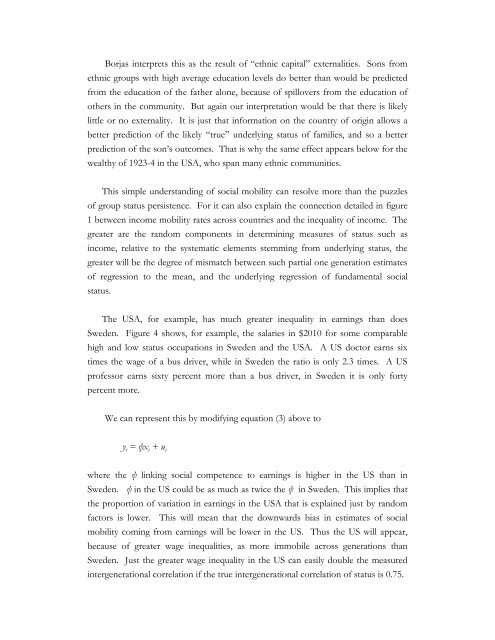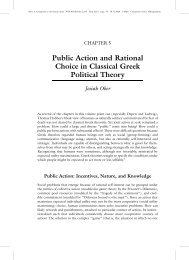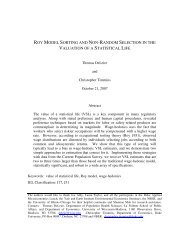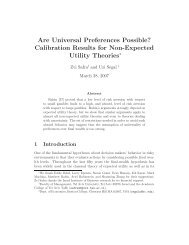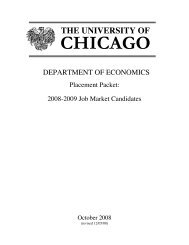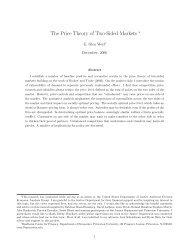Surnames and a Theory of Social Mobility - University of Chicago ...
Surnames and a Theory of Social Mobility - University of Chicago ...
Surnames and a Theory of Social Mobility - University of Chicago ...
You also want an ePaper? Increase the reach of your titles
YUMPU automatically turns print PDFs into web optimized ePapers that Google loves.
Borjas interprets this as the result <strong>of</strong> “ethnic capital” externalities. Sons from<br />
ethnic groups with high average education levels do better than would be predicted<br />
from the education <strong>of</strong> the father alone, because <strong>of</strong> spillovers from the education <strong>of</strong><br />
others in the community. But again our interpretation would be that there is likely<br />
little or no externality. It is just that information on the country <strong>of</strong> origin allows a<br />
better prediction <strong>of</strong> the likely “true” underlying status <strong>of</strong> families, <strong>and</strong> so a better<br />
prediction <strong>of</strong> the son’s outcomes. That is why the same effect appears below for the<br />
wealthy <strong>of</strong> 1923-4 in the USA, who span many ethnic communities.<br />
This simple underst<strong>and</strong>ing <strong>of</strong> social mobility can resolve more than the puzzles<br />
<strong>of</strong> group status persistence. For it can also explain the connection detailed in figure<br />
1 between income mobility rates across countries <strong>and</strong> the inequality <strong>of</strong> income. The<br />
greater are the r<strong>and</strong>om components in determining measures <strong>of</strong> status such as<br />
income, relative to the systematic elements stemming from underlying status, the<br />
greater will be the degree <strong>of</strong> mismatch between such partial one generation estimates<br />
<strong>of</strong> regression to the mean, <strong>and</strong> the underlying regression <strong>of</strong> fundamental social<br />
status.<br />
The USA, for example, has much greater inequality in earnings than does<br />
Sweden. Figure 4 shows, for example, the salaries in $2010 for some comparable<br />
high <strong>and</strong> low status occupations in Sweden <strong>and</strong> the USA. A US doctor earns six<br />
times the wage <strong>of</strong> a bus driver, while in Sweden the ratio is only 2.3 times. A US<br />
pr<strong>of</strong>essor earns sixty percent more than a bus driver, in Sweden it is only forty<br />
percent more.<br />
We can represent this by modifying equation (3) above to<br />
y t = ψx t + u t<br />
where the ψ linking social competence to earnings is higher in the US than in<br />
Sweden. ψ in the US could be as much as twice the ψ in Sweden. This implies that<br />
the proportion <strong>of</strong> variation in earnings in the USA that is explained just by r<strong>and</strong>om<br />
factors is lower. This will mean that the downwards bias in estimates <strong>of</strong> social<br />
mobility coming from earnings will be lower in the US. Thus the US will appear,<br />
because <strong>of</strong> greater wage inequalities, as more immobile across generations than<br />
Sweden. Just the greater wage inequality in the US can easily double the measured<br />
intergenerational correlation if the true intergenerational correlation <strong>of</strong> status is 0.75.


